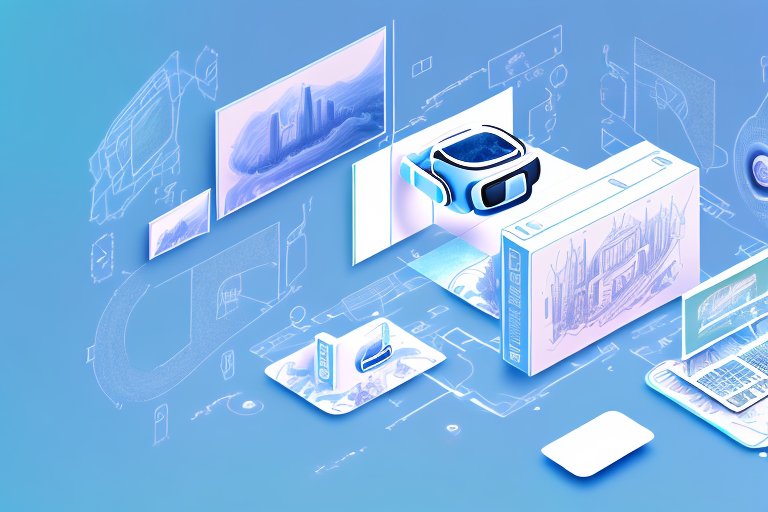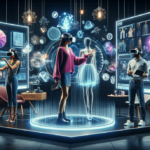Introduction to Virtual and Augmented Reality
Virtual Reality (VR) and Augmented Reality (AR) are transforming the way businesses interact with customers and enhance their operational processes. VR offers an immersive experience by transporting users to entirely virtual environments, while AR overlays digital information onto the real world, enhancing the user's perception of their surroundings.
Understanding VR and AR Technologies
VR and AR technologies utilize specialized hardware such as headsets and smart devices to create interactive and engaging experiences. Recent advancements have made these technologies more accessible and affordable, driving their adoption across various industries.
Current Trends in VR/AR
According to a Statista report, the global AR market is projected to reach $296.2 billion by 2024, highlighting the rapid growth and potential of these technologies in the business landscape.
Benefits and Challenges of VR/AR in Business
Advantages of Implementing VR/AR
- Enhanced Customer Engagement: VR/AR provides interactive and immersive experiences that can significantly increase customer engagement and satisfaction.
- Cost Savings: Virtual simulations can reduce the need for physical prototypes, thereby lowering production costs and speeding up the development process.
- Competitive Differentiation: Offering innovative VR/AR experiences can set your business apart from competitors, attracting a tech-savvy customer base.
Disadvantages and Challenges
- High Implementation Costs: Initial setup for VR/AR can be expensive, including costs for hardware, software, and development.
- Technical Limitations: Current hardware may have limitations in terms of resolution, processing power, and user comfort, which can affect the quality of experiences.
- Specialized Expertise Required: Developing effective VR/AR content often requires specialized skills and knowledge, which can be a barrier for some businesses.
Overcoming Common Challenges
To address these challenges, businesses can collaborate with experienced VR/AR developers, invest in scalable solutions, and stay informed about the latest technological advancements to ensure their VR/AR implementations are both effective and sustainable.
Selecting and Implementing the Right VR/AR Solutions
Choosing the Appropriate Devices
With a plethora of VR/AR devices available, selecting the right one depends on your business needs. Consider factors such as:
- Cost: Determine your budget and explore devices that offer the best value within your price range.
- Ease of Use: Opt for devices that are user-friendly to ensure a smooth experience for both employees and customers.
- Compatibility: Ensure the device is compatible with the software and content you plan to use.
Devices like the Oculus Quest 2 and the Microsoft HoloLens are popular choices for their versatility and robust support ecosystems.
Developing an Implementation Plan
A successful VR/AR implementation requires a well-thought-out plan that includes:
- Defining Objectives: Clearly outline what you aim to achieve with VR/AR, whether it's enhancing customer experience, training employees, or marketing.
- Budgeting: Allocate resources effectively, considering both initial investments and ongoing maintenance costs.
- Timeline: Establish a realistic timeline for development, testing, and deployment of VR/AR solutions.
Measuring ROI
To evaluate the success of your VR/AR initiatives, consider metrics such as user engagement rates, customer satisfaction scores, and cost savings from reduced physical prototyping. Implementing tracking tools and analytics can provide valuable insights into the effectiveness of your VR/AR strategies.
Creating Engaging and Inclusive VR/AR Experiences
Designing Practical and Fun Experiences
Balancing practicality with entertainment is key to creating effective VR/AR experiences. Ensure that your solutions align with your business goals and provide tangible value to users. Incorporate elements like gamification to increase engagement, and use VR/AR for practical applications such as training simulations to enhance learning outcomes.
Accessibility Considerations
Inclusivity is crucial for broad user adoption. Design your VR/AR experiences to accommodate users with different needs by:
- Providing Multiple Language Options: Ensure your content is available in the languages spoken by your target audience.
- Incorporating Accessibility Features: Include features such as subtitles, adjustable settings for different abilities, and intuitive navigation to make experiences accessible to all users.
Integrating VR/AR into Marketing and Customer Engagement
Marketing Strategies Using VR/AR
Leveraging VR/AR in marketing can create memorable and interactive campaigns. For example, virtual showrooms allow customers to explore products in a 3D space, enhancing their decision-making process. According to a Forbes article, businesses using AR in marketing have seen a significant increase in customer engagement and conversion rates.
Enhancing Customer Experience and Retention
By offering personalized VR/AR experiences, businesses can build stronger relationships with customers, leading to higher retention rates. For instance, allowing customers to visualize products in their own environment can increase satisfaction and reduce return rates.
Training and Development with VR/AR
Employee Training Programs
VR/AR can revolutionize employee training by providing immersive learning environments. Simulations can offer hands-on experience without the risks associated with real-world training. A PwC report highlights that VR training can lead to a 30% increase in information retention compared to traditional training methods.
Benefits of VR/AR in Training
- Enhanced Engagement: Interactive simulations keep employees engaged and interested in the training material.
- Safe Learning Environment: Employees can practice skills in a controlled setting, reducing the risk of mistakes.
- Scalability: VR/AR training programs can be easily scaled to accommodate a growing workforce.
Future Outlook and Ethical Considerations
Future Trends in VR/AR Technology
The future of VR/AR holds exciting possibilities, including more advanced haptic feedback, increased integration with artificial intelligence, and broader adoption across various sectors. Emerging trends like mixed reality and the integration of 5G technology are set to further enhance the capabilities and applications of VR/AR.
Ethical Considerations
As VR/AR technologies become more prevalent, it's essential to address ethical concerns such as user privacy, data security, and the potential for addiction. Businesses must implement robust data protection measures and design experiences that prioritize user well-being. Additionally, transparency in data usage and obtaining informed consent from users are critical practices to maintain trust and integrity.
Balancing Innovation with Responsibility
While VR/AR offers numerous opportunities, it's important to balance innovation with ethical responsibility. Developing guidelines and best practices for the responsible use of VR/AR can help mitigate potential risks and ensure that these technologies are used in ways that benefit both businesses and their customers.
Conclusion
Virtual and Augmented Reality technologies present unique opportunities for businesses to enhance customer experiences, streamline operations, and differentiate themselves in competitive markets. By carefully selecting the right devices, creating engaging and inclusive experiences, and integrating these technologies into your business strategy, you can leverage the full potential of VR/AR. Staying informed about future trends and addressing ethical considerations will further ensure the successful and responsible implementation of VR/AR in your business endeavors.




















